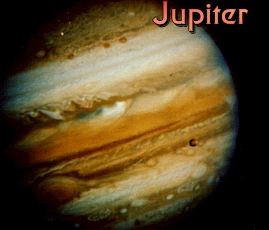

![]()
|
Jupiter (a.k.a. "Jove") was the King of the Roman Gods and the patron of the Roman state. To the ancient Greeks, he was known as Zeus, ruler of the Greek Gods and Mount Olympus. |

|
This is the
symbol for Jupiter:
|
|
|
|
|
Jupiter does not have a solid surface due to its gaseous composition. The swirls and bands we see when looking at Jupiter are the tops of clouds high in its atmosphere. |
|
|
|
|
The vivid colors seen in Jupiter's clouds are probably the result of subtle chemical reactions in Jupiter's atmosphere. The clouds are a different color, depending on its altitude. Blue clouds are lowest, followed by brown and white clouds. Red clouds are the highest. Sometimes we see the lower cloud layers through holes in the upper cloud layers. |
|
|
|
|
Jupiter has faint rings like Saturn's, but much smaller. Unlike Saturn's, Jupiter's rings are dark. They're probably composed of very small grains of rocky material. |
|
|